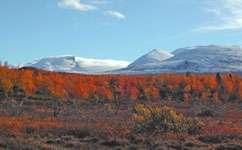Rapid climate change ruled out ice age trees

Short, sharp fluctuations in the Earth's climate throughout the last ice age may have stopped trees from getting a foothold in Europe and northern Asia, scientists say.
According to a new study, warm spells were so brief that trees were unable to establish themselves before the temperature shot back down again.
'The warm events were so short-lived that ecosystems weren't able to respond in full,' says Professor Brian Huntley, of Durham University, who led the study.
'But at the end of the last ice age, about 10,000 years ago, when temperatures were sustained at 5°C or so warmer, whole ecosystem patterns shifted, trees became established and a large number of species became extinct,' he adds.
The research, published in PLoS ONE, could give clues about how rapid changes in today's climate will affect the world's ecosystems.
'If warming is sustained, then it could result in a shift to a new ecological state, and then we can expect a similar loss of species,' says Huntley.
'But if we can make sure that it's just a blip, by bringing temperatures back down quickly, perhaps within a century or two, maybe the consequences for ecosystems won't be so awful.'
Previous computer simulations of vegetation during the last ice age had suggested that trees may have persisted in ice-free areas of Europe and northern Asia. But, curiously, there has never been any sign of trees in fossils from the region.
In an effort to solve the puzzle, Huntley and his team created a new computer model, for the first time taking account of abrupt fluctuations in the Earth's climate, lasting for just hundreds of years, called Heinrich events.
Heinrich events are thought to have been caused as armadas of icebergs broke from away from a vast northern ice sheet, dumping cold, fresh water into the North Atlantic and disturbing the ocean currents that today wrap Britain in a blanket of warm seas.
When you take those rapid events into account, explains Huntley, the computer models begin to agree with the fossil record.
Without trees to contend with, smaller plants and shrubs would have thrived, providing an ideal diet for large, charismatic mammals.
'There would have been many productive herbaceous and fruiting plants,' says Huntley. 'These would have been able to support large numbers of big mammals like mammoths and woolly rhinos.'
More information: Huntley, B. et al. Millennial Climatic Fluctuations Are Key to the Structure of Last Glacial Ecosystems, PLoS ONE, 2013, DOI: 10.1371/journal.pone.0061963
Journal information: PLoS ONE
Provided by PlanetEarth Online
This story is republished courtesy of Planet Earth online, a free, companion website to the award-winning magazine Planet Earth published and funded by the Natural Environment Research Council (NERC).

















